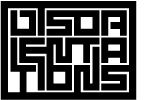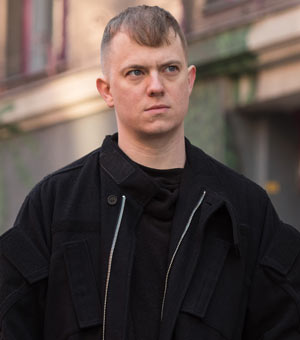Art in the Dark
by Travis Jeppesen on November 28, 2013
Living in Berlin, you become obsessed with light. Throughout most of the year, there is so little of it to go around that one grows heavy with lethargy and despair—it’s all you can do to get out of bed before noon. Imagine how the city’s artists must feel, doomed to create in all that darkness. One year it became so overwhelming that I invested in a full-spectrum sunlamp, the kind that is supposed to brighten your spirits and magically imbue you with summer energy if you just sit before it for half an hour each day. The question I always got was, “Does it really work?” I never knew what to reply. “Well, I haven’t killed myself yet, it must be doing something.”
Sadly, in a later period of financial duress, I had to sell the lamp to my friend Stevie Hanley, an artist I wrote about in my first Atlas column [A.i.A., Dec. ’11]. Stevie will soon leave Berlin to attend the MFA program at the School of the Art Institute of Chicago. But back then, he was very excited by his new purchase. Finally he’d be able to look at the drawings he’d been making all winter in his sun-deprived studio! I haven’t yet asked him what will happen to the sunlamp when he returns home across the Atlantic. I suspect it will pass to another artist comrade, still militant enough to brave the cold and gloom in hopes of spotting a small glimmer through the perpetual gray overhead.
“Friendship,” says writer and freelance curator John Holten in his new novel, The Readymades, “is seeing people you recognize disfigured and mutated again and again, becoming disgusting or loveable in turn.”
As I’ve tried to show in my previous Atlas columns, Berlin is an intense microcosm in which all the components that once made up the art world have been relegated to the fringes, where they fall under the deadening force of a professionalization that now contaminates the entire field. Reflecting this malaise, Holten’s novel is one of the greatest works of art to come out of Berlin in recent years.
Set in a Europe of not too long ago, covering the period that arguably constitutes the formation of our 21st-century milieu (from the 1990s Balkan Wars up to the mid-aughts), The Readymades documents a fictional network of Serbian artists known as the LGB Group (after the surnames of its three core members). Though vaguely reminiscent of real-life collectives from the region such as Irwin/NSK, the OHO Group—and much like an update of fellow Balkanite Tristan Tzara and his Dada cronies—Holten’s artists find themselves caught in the changing tide of history and war.
In defiance of the 21st century’s obsession with the virtual, LGB strives to produce an art of the everyday—having experienced the everyday in its murderous aspect. Their output can take the form of sculptures, performative interventions, drawings or paintings (Holten’s collaborator is the Serbian-born, Berlin-based artist Darko Dragicevic, who created all of the LGB pieces illlustrated in the book), though an argument could be made that the artists’ turbulent relationships with each other are equally important as the work. The bulk of the text is a “reproduction” of an unfinished book by the group’s suicided figurehead, Djordje Bojic (the “B” in LGB). It is less a history of the collective’s activities than an analysis of its members’ varied conditions of estrangement.
Detailing alcoholic and chemical excesses, delirious group orgies, wildly intense interpersonal dynamics, not to mention the alienating effects of a still legible East-West divide on the continent, The Readymades offers an all-too-authentic portrait of the near past, instantly familiar to anyone who has spent time among the decadent elements of the post-Wall Berlin art scene—although the novel is actually set in Paris. (Holten has explained, “Berlin, where I wrote almost all of the book, also fed the details: I’d go out at the weekend to all these bars and clubs and meet people from all over the place. All of that went into the book too; I just changed the setting. Paris is not as exciting as The Readymades probably makes out, whereas Berlin does a passable job.”)
As leader of the group, Bojic becomes the unstable mediator between the opposing impulses of the other two members: the poet Milos Lubarda, whose product is by its nature uncommodifiable, and Aleksandar Gojkovic, whose encounter with the Western art market during the Bush years has corrupted him with dreams of wealth and glamour—which he eventually pursues by becoming an art dealer. (Holten and Dragicevic have gone so far as to create a Gojkovic Gallery website.) The tragedy that haunts all three, of course, is their earlier participation as soldiers in the wars back home. Scars in the collective consciousness of LGB cause the group to shatter before it can fulfill its promise of greatness, despite the international success the artists attain early on.
Berlin, of course, saw its own share of wars in the past century. The Allied bombing and subsequent Cold War paranoia are things of the past, but history, weighing heavily, continues to strike a precarious balance between the Stalinist structures of the former East and the corporate brutalism of the West. For all its many virtues, one always stops short of claiming Berlin is a beautiful city.
Gallerist turned project space director Oliver Koerner von Gustorf suggested in my last column [A.i.A., Mar. ’12] that the only way the art world might change would be if art itself were to change. The Readymades represents one possible scenario: a novelist and artist collaborating to create other artists and their artworks—an entire network, sprung from the mad fantasies of two individuals, infiltrating the world via a novel (which is available from Holten’s own Broken Dimanche Press) and a slew of recent LGB Group exhibitions mounted throughout Europe and at the Armory Show in New York this past March. So you could say that LGB are the Next Big Thing to come out of Berlin: the timely projection of an embattled nexus—East versus West, the Real World versus the Art World, Purity versus Commodification, Literature versus the Visual Arts, Fiction versus Truth.
Thus Belin perpetuates its allure to the young and art-crazed through the gloom of its long winters. By the time you read this, it will be summertime, the city flooded in light. It reaches its zenith at some point in July, when a trace of sun can still be discerned at 11:00 pm, finally disappearing only to reemerge about four hours later. While not as dramatic as the white nights of St. Petersburg or the Nordic lands, Berlin’s lingering summer twilight is strong enough to suggest why so many of us flock to this most nocturnal of cities, and why the streets brim with the energy of reawakening at all hours. As slow-moving as it seems at times, Berlin is a manic beast seething with contradictions. Charting them becomes the task of all artists drawn in by its grace and gravity.
Originally published in the June 2012 issue of Art in America as the third and final installment of my “Atlas Berlin” column. The first can be read here, the second here.


Leave your comment